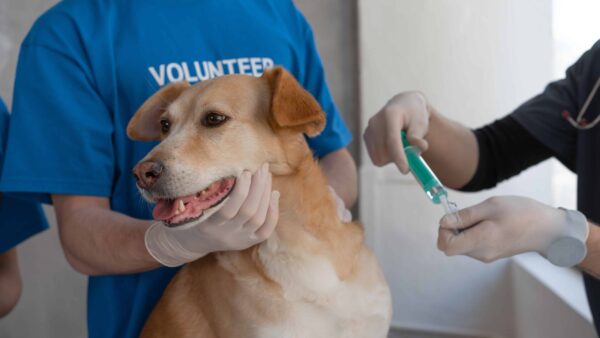Seeing your dog’s skin becoming dry and flaky can be very frustrating for dog owners. However, what causes this issue? why is my dog’s skin dry and flaky?
There are different factors that can cause a dog’s skin to become dry and flaky, this is the major reason why diagnosing the cause of this issue in dogs can be complicating.
In this blog post, we have revealed the causes of dry and flaky skin in dogs, we have also revealed the symptoms and most importantly, home remedies to treat dog flaky skin.
Without further ado, let’s begin!
What Does Flaky Mean on Dog’s Skin?
Flaky skin on a dog could indicate various issues, such as dry skin, allergies, or dermatitis. It’s best to consult with a veterinarian to determine the specific cause and appropriate treatment for your dog’s condition.
Ways On How to Treat Dry and Flaky Skin on A Dog?

In order to make your dog free from flaky skin, you need to do the following.
Regular Bathing:
Bathe your dog with a moisturizing dog shampoo to help hydrate their skin. Avoid over-bathing, as it can strip natural oils.
Proper Nutrition:
Ensure your dog’s diet includes essential fatty acids, like omega-3 and omega-6, which can contribute to skin health. Consult your vet for suitable dietary recommendations.
Supplements:
Consider adding skin-supportive supplements, such as fish oil or coconut oil, to your dog’s diet.
Always consult your vet before introducing new supplements.
Humidify the Environment:
In dry climates, use a humidifier to add moisture to the air, which can benefit your dog’s skin.
Gentle Brushing:
Regularly brush your dog’s coat to remove dead skin cells and distribute natural oils. Use a brush suitable for your dog’s coat type.
Hydrating Topical Treatments:
Apply veterinarian-recommended moisturizing balms or creams to soothe and hydrate your dog’s dry skin.
Consult a veterinarian:
If dryness persists or worsens, consult your veterinarian for a thorough examination. Underlying health issues might be contributing to the skin condition.
Always tailor your approach based on your dog’s specific needs and consult with a vet for personalized advice.
What Causes Dogs Skin to Peel Off?

The main causes of peeling skin in dogs include:
- Allergies: Environmental factors, certain foods, or contact allergens can trigger allergic reactions leading to skin issues.
- Infections: Bacterial, fungal, or yeast infections can cause skin irritation and peeling.
- Parasites: Fleas, ticks, or mites can infest a dog’s skin, causing irritation, itching, and peeling.
- Autoimmune Disorders: Conditions like pemphigus or lupus may lead to the immune system attacking the skin, resulting in peeling.
- Nutritional Deficiencies: Inadequate nutrients in the diet can affect skin health, leading to peeling and other dermatological problems.
It’s very important to consult a veterinarian to identify the specific cause and determine the appropriate treatment for your dog’s skin condition.
What Does Dry Skin Look Like on A Dog?
Dry skin on a dog may appear flaky, rough, or scaly. However, you might notice excessive shedding, dandruff-like flakes, and the skin may feel rough to touch.
Dry skin can also cause itching, leading the dog to scratch or lick the affected areas. If you observe continuous dryness or skin issues, consulting with a veterinarian is recommended for proper diagnosis and treatment.
Can I Put Vaseline on My Dog?

While some pet owners use Vaseline sparingly on their dogs, it’s crucial to do so cautiously. Vaseline can be applied to a dog’s paws, nose, or dry skin, but avoid areas where the dog can easily lick it off.
Here’s a simple process:
- Check with your vet: Always consult your veterinarian before using any products on your dog’s skin to ensure it’s safe for your specific pet.
- Clean the area: If you’re applying Vaseline to dry or cracked skin, clean the area gently with a mild, pet-safe cleanser.
- Apply a thin layer: Use a small amount of Vaseline and apply a thin layer to the desired area. Avoid applying it to large areas or areas where your dog can easily ingest it.
- Monitor your dog: Keep an eye on your dog to make sure they don’t lick off the Vaseline. If they do, it’s important to contact your vet, as ingesting too much can lead to digestive issues.
However, remember, Vaseline is not a substitute for proper veterinary care. If your dog has a serious skin condition or discomfort, consult your vet for appropriate advice and treatment.
Can I Rub Coconut Oil on My Dog?
Using coconut oil on your dog’s skin is very beneficial, as it may help moisturize and soothe dry skin. However, it’s essential to start with a small amount to ensure your dog doesn’t have an adverse reaction.
If your dog has a history of allergies or skin issues, it’s good to consult with a vet before applying coconut oil. All in all, in moderation, coconut oil is generally considered safe for dogs.
What Is the Medical Term for Dog Flaky Skin?
The medical term for dog flaky skin is “seborrhea,” which is a condition characterized by excessive scaling or flaking of the skin.
What Is the Best Oil for Dogs’ Skin?
The best oil for a dog’s skin often depends on the specific needs of the dog and any existing skin conditions. These are some commonly recommended oils and their benefits:
- Fish Oil: Rich in omega-3 fatty acids, fish oil can help improve skin health, reduce inflammation, and promote a shiny coat.
- Flaxseed Oil: Another source of omega-3 fatty acids, flaxseed oil is beneficial for skin and coat health. It may also help with inflammation and itching.
- Coconut Oil: Contains lauric acid, which can have antimicrobial properties. Coconut oil is often used to soothe dry skin and may aid in reducing itching.
- Olive Oil: High in monounsaturated fats, olive oil can be beneficial for maintaining a healthy coat and may provide relief for dry, itchy skin.
- Sunflower Oil: Rich in vitamin E, sunflower oil can contribute to skin health and act as an antioxidant.
Always introduce any new supplement or oil gradually, and it’s crucial to consult your veterinarian before making significant changes to your dog’s diet or skincare routine. They will provide you with a good advice based on your dog’s specific needs and health conditions.
What Is Fungal Dermatitis in Dogs?
Fungal dermatitis in dogs refers to a skin infection caused by fungi, commonly dermatophytes. It can lead to symptoms such as redness, itching, hair loss, and scaly skin.
Ringworm is a common fungal infection in dogs. Consult a veterinarian for proper diagnosis and treatment if you suspect your dog has fungal dermatitis.
{FAQs} PEOPLE ALSO ASK
What Is Dog Mange?
Dog mange is a skin condition caused by mites infesting a dog’s fur and skin. There are two main types: sarcoptic mange, caused by Sarcoptes scabiei mites, and demodectic mange, caused by Demodex canis mites.
Symptoms of dog mange include hair loss, itching, and skin irritation. Veterinary attention is crucial for diagnosis and appropriate treatment.
What Is the Best Antibiotic for Dogs with Skin Infections?
Amoxicillin/Clavulanate—This antibiotic mixture is related to Penicillin which is used for the treatment of a broad spectrum of bacterial infections, including body disease, and other crucial infections.
How Can I Moisturize My Dog’s Skin Naturally?
You can moisturize your dog’s skin naturally by using options like coconut oil, olive oil, or aloe vera gel. Gently massage a small amount of any of these ingredients onto their skin, focusing on dry areas.
Conclusion
To prevent flaky skin in dogs, ensure they have a balanced diet with essential fatty acids, groom regularly to remove loose fur, use a moisturizing shampoo designed for dogs, and maintain a proper bathing schedule to avoid over-drying their skin.
Reading this article to this point, I am sure you would have been able to pick up the necessary information you need to know. Answers to your questions are above and if you need to understand more, kindly read the article again.







Leave a comment